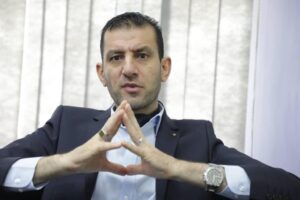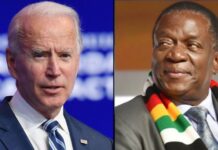
Talkmore Gandiwa
Standing at the centre of the conflicts, young children run to and from with confused minds as they try to run away from the horrific terror of the Israeli forces, who continue to illegally invade the sovereign state of Palestine.
As the Israeli forces advanced more into the Palestinian land, small children, including 9-year-old Salim, hid in the basement of his home,” a residential facility for orphans and children whose families could not afford to care for them.
“I heard lots of explosions outside and felt very scared,” he says hesitantly. “But my friends kept talking to me and helped to calm me down. Still, he worried the shelling would last forever.
But later that day, his parents decided that the holy city was no longer safe with the cramped conditions in the community, as they feared being bombed at any given time.
The Palestinian ambassador to Zimbabwe, Tamer Almassri, has condemned the Israel invasion as the Israeli police target Palestinians with discriminatory arrest, torture, and unlawful force.
Since the beginning of the year, 170 Arab citizens have been killed in crime-related shootings.
The police have an obligation to protect all people under Israel’s control, Jewish or Palestinian, but “the Israel police have failed to protect the lives of the Palestinians,” said Almassri.
Adding on, he said, the Palestinians are suffering from racism and are denied equal job opportunity.
A detour into the Palestinian and Israeli conflict
Although the Second World War and the Holocaust had just ended when the current state of Israel was established in May 1948, the antagonism between Israelis and Palestinians actually dates back much deeper.
Historians and observers provide varying perspectives as to when this chapter of history began. Documentary filmmaker Rawan Damen starts her tale in her series Al Nakba (2008) on Al Jazeera with Napoleon Bonaparte, who suggested a Jewish homeland in Palestine as early as 1799 in the wake of the siege of Acre during his fight against the Ottoman Empire.
However, 41 years later, when British foreign secretary Lord Palmerston wrote to his ambassador in Istanbul, urging him to press the Sultan to open up Palestine to Jewish immigrants as a means of countering the significant influence of Egyptian governor Mohammed Ali, the French commander’s attempt to establish a European stronghold in the Middle East was revived.
At that time, there were only around 3,000 Jews living in Palestine, but wealthy donors like French nobleman Baron Edmond de Rothschild started to fund people from Europe to join them and create settlements, the most important of which was Rishon Le Zion, built in 1882.
As Jews, particularly those from Eastern Europe, began to immigrate to Palestine, the Austrian author Nathan Birnbaum invented the word “Zionism” in 1885.
A decade later, Dr. Theodor Herzl, an austro-hungarian writer, published The Jewish State, which predicted the creation of such a state with the advent of the 20th century. Al Nakba claims that two rabbis were dispatched to Palestine by Max Nordau, a friend of Herzl’s, to study the viability of the idea. They returned with the following message: “The bride is beautiful, but she is married to another man. However, the veracity of this tale is disputed.
The First Zionist Congress was arranged by Birnbaum, Herzl, and Nordau in Basel, Switzerland, in 1897 to talk about their vision of an independent Jewish homeland and their strategies for lobbying European powers to make it a reality.
In order to strengthen its influence, Britain was pondering the necessity for a “buffer state” in the Middle East by 1907. Chaim Weizmann, a scientist and the leader of the British Zionist movement, would come to Jerusalem at this time to create a business involved in purchasing land close to Jaffa. In the Marj Bin Amer district of northern Palestine, 10,000 dunums—an antique land measurement comparable to acres—had been bought within three years, driving 60,000 indigenous farmers out to make room for Jewish immigrants from Yemen and Europe.
In response to the creation of the Jewish militia Hashomer to defend the expanding settlements, Palestinian chemist Najib Nassar launched the publication Al-Karmel to issue warnings against what he saw as a colonising force.
With “Mohammedans” being viewed with suspicion, Britain’s interest in establishing an allied presence in Palestine increased with the start of World War One, not the least of which was to increase its control over the Suez Canal.
Herbert Samuel, a member of the Liberal Party, wrote his covert letter, The Future of Palestine, in January 1915. It was shared with the Cabinet and supported annexation and the country’s progressive transformation into an independent Jewish state under the British Empire’s protection.
The next year, Sir Mark Sykes and Francois Georges-Picot, the architects of the Sykes-Picot Agreement that defined the spheres of influence of the British and French in the event of the fall of Ottoman control, secretly reviewed Samuel’s ideas.
In a letter from David Lloyd George’s foreign secretary Arthur Balfour to Jewish community figure Walter Rothschild, 2nd Baron Rothschild, on November 9, 1917, the British government officially declared its support for the establishment of a “national home for the Jewish people” in Palestine, effectively assuming ownership over a piece of land that many would argue it had no legal right to give away.
A month later, just before General Edmund Allenby took control of the holy city of Jerusalem on December 11, 1917, Rothschild, Samuel, Sykes, and Weizmann spoke at a joyful gathering in London.
Following the defeat of the Kaiser and the end of the Great War, US President Woodrow Wilson requested a study of the non-Turkish regions of the defunct Ottoman Empire by academic Dr. Henry King and orientalist Charles Crane. Their findings revealed that Palestine’s non-Jewish population was “emphatically against” the Zionist project, with nearly 90% of them being non-Jews. The writers expressed concern about the fervour of the feelings and recommended that Jewish immigration be restricted for the sake of peace, but their arguments were largely disregarded by the world community, and their findings were hidden until 1922.
At the 1919 Paris Peace Conference, lieutenant-colonel TE Lawrence (often referred to as Lawrence of Arabia) mediated the signing of an agreement between Weizmann, then the head of the Zionist delegation, and his Arab counterpart Prince Faisal bin Hussein, committing both parties to the establishment of an independent Arab state in the Middle East and a Jewish homeland in Palestine.
At the 1919 Paris Peace Conference, lieutenant-colonel TE Lawrence (often referred to as Lawrence of Arabia) mediated the signing of an agreement between Weizmann, then the head of the Zionist delegation, and his Arab counterpart Prince Faisal bin Hussein, committing both parties to the establishment of an independent Arab state in the Middle East and a Jewish homeland in Palestine.
As the decade went on, large-scale demonstrations against Jewish immigration started to occur, and the Palestinian movement strove in vain to oppose and fight what its members saw as a usurper supported by imperial Britain’s military and diplomatic might.
Nearly 250 Jews and Arabs were killed and many more were injured in the disaster that became known as the Buraq Revolt in August 1929 at the Wailing Wall when Palestinians hoisted black flags when Balfour visited Jerusalem. In an act of cruelty meant to serve as a deterrent, Sir John Chancellor, Sir Samuel’s successor, executed three Muslim men for their involvement in the uprising.
However, when more Jewish immigrants came to the country to establish themselves—the number increasing from 4,000 in 1931 to 62,000 in 1935—protests persisted and reached a fever pitch in 1933. British forces shot and killed Muslim revolutionary leader Sheikh Izz ad-Din al-Qassam in the hills above Jenin the same year.
The strength of opposition to British colonial power forcing the Balfour Declaration on a people who disapproved of it led to a six-month general strike in 1936. It was an incredible feat of organising, but the backlash that followed resulted in the destruction of Palestinian houses.
In an effort to counter Adolf Hitler’s Nazi Germany, whose Third Reich would ultimately be proven guilty of the execution of six million Jews in extermination camps and concentration camps, the rest of the world would be thrown into war once more in 1939.
A 1942 meeting held at the Biltmore Hotel in New York would solidify American-Zionist relations just after the US entered the war. This took place against the backdrop of the Irgun, an armed Zionist paramilitary organisation that had been battling local Arab factions in Palestine for several years.
The 91 fatalities from the bombing of the King David Hotel in Jerusalem on July 22, 1946, and the 107 fatalities from the Deir Yassin Massacre on April 9, 1948, both committed by Irgun in association with another group, Lehi (or the Stern Gang), would make them legendary.
Lehi would kill Folke Bernadotte that summer, a Swedish ambassador sent by the UN to settle the conflict.
Following the Allied victories in Europe and the Pacific in 1945, world powers turned their attention to ending the violence in Palestine.
A two-state solution to the disputed territory almost came into being in 1947, when the UN General Assembly volunteered Resolution 181, which proposed carving a new state from Palestine west of the River Jordan: one housing Jews, the other Arabs.
The resolution was adopted after a vote, allegedly as a result of diplomatic pressure from the US, but rejected by the Palestinians, who argued that Jewish residents owned no more than 5.5 percent of the land at the time and so had no right to receive 56 percent, in addition to the accompanying international legitimacy. Jewish jubilation met with Arab hostility, and a civil war duly erupted.
David Ben-Gurion, the first Israeli prime minister, formally established the state of Israel in Tel Aviv in 1948.
Nevertheless, the state of Israel was established on May 14, 1948, with the end of the British Mandate, under the leadership of Prime Minister David Ben-Gurion, and received immediate recognition from the US and the USSR. However, this led to the start of the bloody Arab-Israeli War, which saw 3,000 resistance fighters rise up against the new nation and forced 700,000 Palestinians to flee the fighting, often without citizenship.
Every year on “Nakba Day,” which is called after the Arabic term for “catastrophe” and commemorates the displacement of the Palestinian people on that date, Palestinians deliver speeches, organise marches, and display the keys to the homes they were compelled to leave behind but still wish to return to.
Resolving that Palestinians “who want to return to their homes and live in peace with their neighbours should be given the right to do so as soon as possible,” the UN General Assembly adopted Resolution 194 in December 948. Israel, however, rejected the idea as a danger to the fledgling state’s exclusivity as a Jewish state. The United Nations Relief and Works Agency (UNRWA) for Palestine Refugees in the Near East was founded by the chamber a year later to provide more aid to the displaced.
On those two occasions, Israel negotiated armistice agreements with its neighbours in Jordan, Egypt, Lebanon, and Syria.
In 1950, Jordan took over administrative administration of the West Bank, while Egypt held onto Gaza. This arrangement lasted until the Six-Day War of 1967, when Israel’s soldiers seized control of those areas.
Before it, there was intermittent violence. In the villages of Qalqilya, Kufr Qasim, and Khan Yunis in 1956 and in As-Samu in 1966, notable killings occurred.
The Palestinian Liberation Organisation (PLO) was established in Cairo in 1964 with the goal of achieving the “liberation of Palestine” through an armed uprising rather than focusing on human rights issues. The PLO would not change its position until 1993, after which Israel and the US designated the PLO as a terrorist organisation. In 1974, the Arab League recognised it as the only representation of the Palestinian people.
Following new violence caused by Israel’s 1967 military push into the Gaza Strip, West Bank, Golan Heights, and Egyptian Sinai, the UN Security Council adopted Resolution 242, requiring Israel to withdraw from areas it deemed to be occupied. A council was disregarded.
Following the Yom Kippur War, the Security Council would adopt Resolution 338, which again demanded Israel withdraw from its 1967 invasions and called for a cease-fire. Israel declined once more.
Palestinians have always observed March 30, 1976, as “Land Day,” since it was the day that Israeli land confiscations in communities from the Sea of Galilee to the Negev were met by riots, strikes, and more violent retaliation.
The Camp David Accords were signed at President Jimmy Carter’s Maryland hideaway on September 17, 1978, when Israeli Prime Minister Menachem Begin and Egyptian President Anwar Sadat met. One of the framework agreements brought about peace between their two countries and earned its signatories the Nobel Peace Prize, but the other, which dealt with Palestine’s future in the disputed territories, would be denounced by the UN because it was reached without the participation of a Palestinian delegation.
Israel invaded Lebanon in 1982, and before the decade’s conclusion, the first Intifada in the Palestinian territories would break out in protest of the occupation. However, when the PLO publicly recognised the establishment of Israel by accepting UN Resolutions 242 and 338, more baby steps towards peace were made. In 1991 and 1992, negotiations stopped once more with little sign of a breakthrough.
Then, in the summer of 1993, Israeli Prime Minister Yitzhak Rabin and PLO Chairman Yasser Arafat signed the Oslo I Accord, which called for the establishment of the Palestinian National Authority as an interim Palestinian government and the withdrawal of Israeli Defence Forces from territories that were still viewed as being occupied. Following Oslo I in 1995, Oslo II offered Palestinians autonomy in some areas of the West Bank and Gaza but, once again, did not propose the establishment of a Palestinian state.
A tentative cease-fire persisted until a second Intifada saw Israel retake West Bank towns in 2002. This destabilising event would be made worse by Arafat’s passing in 2004, which was a significant setback for the Palestinian cause.
Since then, there has been an increase in violence, with Israel starting a war with Hezbollah in Lebanon in 2006 and repeatedly attacking Hamas in Gaza with operations like Operation Cast Lead (2008), Operation Pillar of Defence (2012), and Operation Protective Edge (2014). On Nakba Day, there was more violence in both 2017 and 2018, with the latter becoming so violent that it called for a UN war crimes probe.
With the election of Donald Trump as US president, the situation was further upended. The former reality television star made friends with Israeli Prime Minister Benjamin Netanyahu, moved the US embassy from Tel Aviv to Jerusalem in recognition of the city’s status as Israel’s capital, and then declared the Golan Heights Israeli territory, defying the general consensus among nations that the area had been illegally annexed.
Jared Kushner, his Jewish son-in-law, was foolishly given the responsibility of creating a plan to bring peace to the Middle East by Mr. Trump, a task the junior real estate tycoon was convinced he could complete without prejudice after reading no less than 25 books on the topic. Mr. Trump also halted US financing for the UNRWA.
The ensuing escalation of tensions in Gaza that led to further casualties from rocket attacks launched by Israel and Hamas is only the most recent example of a quarrel that has plagued the region’s bloody history.













